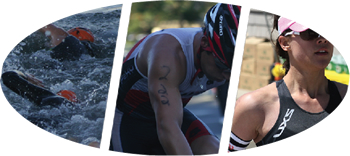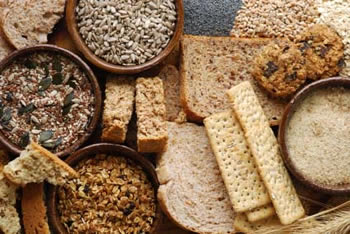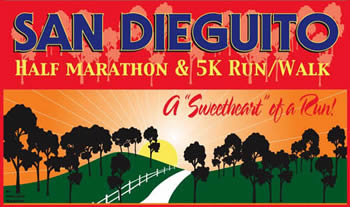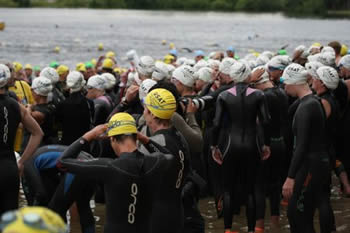FIVE REASONS YOU HAVEN’T TRIED A TRI
Jarrett Pflieger

It is human nature to be scared of unfamiliar territory. We are all excellent at making excuses to keep ourselves from going out of our comfort zone and trying something new. These excuses could be keeping us from doing things that could change our lives for the better.
For many people, the idea of competing in a triathlon can be a scary thing. There are countless excuses not to try a triathlon, but even more reasons why you should. Here are some common excuses keeping people from venturing into the sport and why they may not be very good ones.
I don’t have enough time to train:
The average American spends an average of 127 hours watching television and 26 hours on the Internet per month. Even a quarter of this amount of time is more than enough to train for all three sports included in a triathlon. Depending on the distance you choose to race, you can easily get enough quality training with less than 10 hours a week.
Not to say that training for a triathlon isn’t a sacrifice, because many times you do have to give up some things, but a few less hours a week on Facebook and Twitter could make a world of difference. So turn off those reality TV shows and lace up your running shoes, in the end you will not regret it.
I’m not a (swimmer/cyclist/runner):
You do not have to already be good at all three sports, or any of them, to compete in a triathlon. Even world-class triathletes have weaknesses they must work on to even be competitive. It helps to come from a background in one of the three sports, but there are plenty of excellent triathletes that had no prior experience in any of the sports before doing their first triathlon. You may have to put in more time in one or two of the sports to get them up to par with the others, but a good coach and training plan can definitely get you there.
I’m too out of shape:
All the more reason to try a triathlon. There are people of all different ages, shapes, and sizes competing in triathlons. Anyone can do it if they start slow and build their fitness up one step at a time. If you go out too hard, too fast, you may get burned out before your body has time to catch up. Again, a good training plan and a coach can help you progress at a rate that is appropriate for your abilities.
I’m scared of not finishing:
Not finishing is always a possibility. Flat tires, crashes, and injuries have kept even the best triathletes from the finish line. There are certain things you can’t control, but one thing you can control is how you prepare. Put the time in, put your miles in, and you won’t have to worry about your fitness being what keeps you from finishing. Even if you don’t finish, you still did what 99% of people have never done. You stepped up to the starting line of a triathlon and gave it all you had.
I have no idea where to start
There are an infinite number of resources to help you start your triathlon journey. Check out websites like, www.triathica.com www.beginnertriathlete.com or many others dedicated to helping new athletes figure out what they need to do to succeed. There are thousands of books dedicated to the subject as well including Triathica’s Triathlon Roadmap as well.
You can also join your local triathlon club to find training partners, get advice, and ask questions. Find a certified triathlon coach to help you create a custom training plan based on your abilities and available training time. There is no shortage of information on how to start training for a triathlon if you know where to find it. So get out there and try something new. Even if you only do one race, it is something you carry with you forever.
PERIODIZING YOUR NUTRITION
Jarrett Pflieger
Successful triathletes know that periodizing their training is the key to getting the best results possible. Periodization is defined as the “progressive cycling of various aspects of a training program during a specific period of time.” When an athlete periodizes their training, they basically break down their training year into smaller cycles. Each cycle’s goal is different and works on a different aspect of a triathlete’s performance. One cycle may be to focus on longer and slower distances to increase endurance, while another cycle may focus on higher intensity efforts to raise an athlete’s lactate threshold and enable them to go faster while fatiguing less.
When an athlete changes up their training like this, their nutritional requirements also change. In order to get the most out of training, the foods you eat should change along with your training. How does this work?
Once we start thinking about food as fuel, it becomes clearer. When you are in your highest volume of training, your body needs extra fuel to give your body the energy it needs to get through your workouts. When in the offseason or a lower volume cycle, the goal should be eating clean foods and managing or losing any extra weight.
Many athletes make the mistake of trying to lose a few extra pounds before a race, but this is when you need to be keeping your body adequately fueled by eating more. The time to lose weight is not in the cycle leading up to the race, but much earlier during offseason or a low intensity cycle far out from your race.
Here are a few guidelines to help you periodize your nutrition along with your training:
– If you need to lose extra weight, stick with a high lean protein diet with lots of fruits and vegetables. Keep carbohydrate intake to a minimum. This should only be done far out from a race when training volume is low.
 – When your training starts to increase during a build phase, begin to incorporate more whole grains and complex carbohydrates into your diet. Stick with whole wheat bread, brown rice, oatmeal, etc. Try to stay away from processed carbs, sugars, and fatty foods. Make sure to indulge every once in a while, but don’t overdo it.
– When your training starts to increase during a build phase, begin to incorporate more whole grains and complex carbohydrates into your diet. Stick with whole wheat bread, brown rice, oatmeal, etc. Try to stay away from processed carbs, sugars, and fatty foods. Make sure to indulge every once in a while, but don’t overdo it.
– During your race phase, make sure you are taking in plenty of complex carbs to fuel your intense workouts. This is not the time to go on a diet and limit your calories.
– Just listen to your body and increase caloric intake slowly to discourage rapid weight gain. If you are not hitting your goal times and have trouble completing longer distance workouts, you might not be eating enough. If you start gaining weight rapidly, you may be eating too much.
A certified dietitian can help you create a custom nutrition plan. If you need some help creating a periodized training plan, consult a certified triathlon coach. Get your nutrition plan on pace with your training plan and you will be surprised at what you can do.
RACE REPORT: SAN DIEGUITO HALF MARATHON
Ron Saetermoe

Until a couple weeks ago I’d never heard of the San Dieguito Half Marathon. That’s the problem with living in paradise – there are so many great options.
As you know, I’m into my Ironman training now, and as part of that I love the half marathon race distance. The distance really seems to help build speed and endurance without trashing you for a couple weeks.
San Dieguito is down in Rancho Santa Fe in San Diego County just east of Solana Beach. The area is beautiful with lots of trees and hills. Seven of us carpooled down there, which was fun in itself. Since we had a woman on board we were all on our best behavior (no farting!).
The weather was perfect and San Dieguito Park was beautiful. Truly a great place for a picnic if you’re looking to get away.
The race starts down the hill from San Dieguito Park and winds through the streets of Rancho Santa Fe, over the aforementioned hills. Hills at times that didn’t seem to have an end!
Scott (Scooter) Callender and Larry (Lar Dog) Davidson set the pace for our group. I started to run with Gary Clendenin but couldn’t hang with him.
At about mile two I saw Lar Dog off on the left side of the road working on his foot. He had a sharp pain in the top of his foot that forced him to stop. After about a minute he’d fixed the problem and promptly blew by me.
Shortly after that I passed Gary at one of the aid stations. I didn’t look back but thought he was just behind me. It wasn’t until later that I saw he’d dropped back a bit.
Since I loaded my legs from a 50+ mile bike ride the day before with Stu Lowndes into Huntington Beach I was hurting the entire way (RPE 10). There were opposing forces at work. My legs ached so they didn’t want to go fast but my heart rate was also up because I’d trashed myself the day before. Either way there wouldn’t be a PR in it for me today.
Everyone had a great time but Scooter absolutely killed this really tough course!
Scott Callender: 1:30:58 (6:57)
Larry Davidson: 1:33:55 (7:10)
Ron Saetermoe: 1:37:23 (7:26)
Kari Krause: 1:37:28 (7:27)
Gary Clendenin: 1:38:24 (7:31)
Sara Gilles: 1:39:43 (7:37)
Pete Kobrak: 1:41:42 (7:46)
Other notable racers:
Kate Major: 1:20:24 (6:08)
Michellie Jones: 1:22:18 (6:17)
Joanna Zeiger: 1:22:42 (6:19)
TAPER PERIOD
Ron Saetermoe
So your “A” race is over. You’re probably feeling good about your experience (if you prepared adequately) and are still hobbling around and nursing your blisters. Good for you!
What’s next? This is typically when many triathletes start getting depressed. All of the hard work is behind them and there is no immediate goal on the horizon. Wow! No mandatory 4:30 a.m. alarms and jumping into a freezing pool!
Your top priority now is to slack off! That’s right; take it easy for the next several weeks. Sleep in, eat some fast food and stay off your feet.
This period in your training is just as important as all of the other periods because you need to allow your body to heal from the constant pounding you’ve been giving it. Many triathletes worry about losing all of the hard-earned fitness during this period, and you will lose some, but it will come back.
My favorite activities when I’m in the taper period is swimming, easy bike rides and walking. All three will help you recover and won’t tax your body unnecessarily.
Enjoy these weeks. Plan your next season and just take it easy . . .
The key things about the Taper Period are:
– Any workouts should be directed toward recovery not fitness building
– Concentrate on low impact exercise with low intensity
– It’s okay to so some light resistance training
– Enjoy the taper . . . next season is just ahead!
Here’s what the ideal Triathica year looks like:

Again, we feel that three, three-week cycles within each period is optimal for building fitness and recovery. The time to build strength, speed and endurance is upon you. Make the best of it!
Cheers!
Ron
PRE-RACE NERVOUSNESS
Ron Saetermoe
 This subject has been written about plenty of times but I thought I’d give you my take on it. First, I’ve been racing since 1983 and have done well over 100 races and I still get nervous. So, if you’re thinking the more you do this the less nervous you’ll get, you’re dreaming.
This subject has been written about plenty of times but I thought I’d give you my take on it. First, I’ve been racing since 1983 and have done well over 100 races and I still get nervous. So, if you’re thinking the more you do this the less nervous you’ll get, you’re dreaming.
Some say the nervousness you feel is a good thing. I don’t know if it is or not. All I know is that I have it. The key thing for me is learning how to channel it and deal with it.
I find that I’m more nervous before “big” races than less important races( DUH!). Makes sense, but if you think about it rationally, this will help reduce the tension before your lesser important races. Stress before the “big” races, not the smaller ones.
Sleep is crucial to performing at your best. The problem is that it’s frequently difficult to sleep the night before a race. So here’s what I do. I aim to sleep as much as possible two nights before the race, knowing that I’m not likely to get too much sleep the night before the race. Then, you’ll at least have some energy still in the tank.
Another ploy I have is to take a nap the day before a race. Now, when I nap I’m only grabbing 20 – 30 minutes. That way it won’t keep me up later that night.
When you’re on the road and sleeping away from your own home it’s best to try to do whatever relaxes you. Go to the spa or steam room, read a book, eat your favorite comfort food, have a glass of beer or wine. Anything that will help you wind down.
So why is it important to get sleep anyway? Won’t the adrenaline carry me through the race? One of the main reasons you want to get plenty of sleep is because the body and mind repair themselves when you’re at rest. If you track your heart rate on a regular basis, notice what your heart rate is when you wake up from a morning of good sleep and another when you didn’t. You’ll find your “resting heart rate” is between 5 to 10 beats faster when you don’t get good rest.
And, yes, the adrenaline may carry you through to the finish but if you’re well rested you’ll always perform better.


